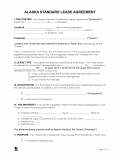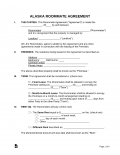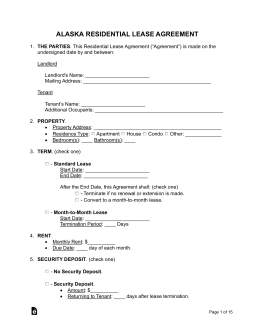Updated October 23, 2023
An Alaska lease agreement is a document used to allow a landlord to rent a property to a tenant for monthly payment. The landlord will write the lease after making a verbal agreement and checking the tenant’s financial credentials. After both parties sign the lease, the landlord and tenant will be obligated to its terms until the end date.
Table of Contents |
Agreement Types (6)
 Standard Lease Agreement – Fixed arrangement of usually one year but can be for any amount of time as agreed by the parties. Standard Lease Agreement – Fixed arrangement of usually one year but can be for any amount of time as agreed by the parties.
Download: PDF, MS Word, OpenDocument |
 Commercial Lease Agreement – For the use of any type of business-related property such as retail, office, or industrial. Commercial Lease Agreement – For the use of any type of business-related property such as retail, office, or industrial.
Download: PDF, MS Word, OpenDocument |
 Month to Month Lease Agreement – Known as a “tenancy at will,” which allows either party to cancel the arrangement with at least 30 days’ notice from either party.[1] Month to Month Lease Agreement – Known as a “tenancy at will,” which allows either party to cancel the arrangement with at least 30 days’ notice from either party.[1]
Download: PDF, MS Word, OpenDocument |
 Rent-to-Own Lease Agreement – A standard residential lease with the added benefit of having the power to purchase the property during an agreed-upon option period. Rent-to-Own Lease Agreement – A standard residential lease with the added benefit of having the power to purchase the property during an agreed-upon option period.
Download: PDF, MS Word, OpenDocument |
 Room Rental (Roommate) Agreement – To be signed by all the members of a shared living situation to establish the rules for common areas and payment(s) for utilities. Room Rental (Roommate) Agreement – To be signed by all the members of a shared living situation to establish the rules for common areas and payment(s) for utilities.
Download: PDF, MS Word, OpenDocument |
 Sublease Agreement – A tenant may elect to have someone else move in and continue the lease under the current arrangement with the landlord. Sublease Agreement – A tenant may elect to have someone else move in and continue the lease under the current arrangement with the landlord.
Download: PDF, MS Word, OpenDocument |
Required Disclosures (3)
- 7+ Day Absence – The agreement must state that if the tenant leaves the property for more than seven (7) days, the landlord must be notified.[2]
- Lead-Based Paint Disclosure – Federal law requires all housing units built prior to 1978 to issue this disclosure and brochure to new tenants.[3]
- Identification – The landlord must write the person(s) authorized to receive notices/demands by the tenant.[4]
Security Deposits
Maximum Amount – The landlord can charge a maximum amount of two (2) months’ rent unless the amount is more than two thousand dollars ($2,000), under which there is no maximum.[5]
-
- Landlord – There is no requirement for a landlord to collect interest on behalf of the tenant.
- Real Estate Broker – If a real estate broker deposits a security deposit into a trust account, any interest earned is to be paid to the tenant (trustor).[6]
Separate Bank Account – A security deposit collected must be in a separate bank account designated solely for prepaid rent and deposits. The separate bank account can combine deposits and prepaid rent from other tenants.[7]
Returning to Tenant – A security deposit must be returned within fourteen (14) days if the tenant leaves on time or gives proper termination or thirty (30) days if the tenant did not give proper termination to the landlord. If the tenant leaves without proper notice, the landlord has 30 days to return the deposit to the tenant.[8]
- Itemized List – If there are any deductions at the end of the lease term, the landlord must give an itemized list of damages.[9]
When is Rent Due?
Grace Period – There is no rent grace period in Alaska. The rent is due on the day mentioned in the lease agreement.[10] If rent is late, the landlord can give the tenant a 7-day notice to quit, allowing them to pay rent or vacate.[11]
Maximum Late Fee ($) – There is no statutory limit. Therefore, the landlord can charge as much as desired if mentioned in the lease.
NSF Fee – The landlord can charge $30 per occurrence of a bad check being used.[12]
Withholding Rent – The tenant cannot withhold or deduct rent to fix repairs. If the landlord is in noncompliance with the rental agreement, the tenant can give notice that the lease will terminate in 20 days if the demands are not met in 10 days.[13]
Right to Enter (Landlord)
Standard Access – The landlord must give at least twenty-four (24) hours’ notice to the tenant before entering the property.[14]
Immediate Access – The landlord can enter the property in the event of an emergency.[15]
Abandonment
Absence – Included in an agreement is a disclosure that the tenant must give notice to the landlord if absent for at least 7 days.[16] This notice doesn’t have to be immediate, but when the tenant becomes aware, they will be away from the property for such time.
Breaking a Lease – If a tenant vacates the property early, they are liable for the remaining lease term unless the landlord re-rents the property. In such an event, the tenant will owe the landlord for the months the property was vacant under the original lease period.[17]
Utility Shutoff – If a public utility that provides electricity, natural gas, or water to the property is discontinued by the tenant due to failure to pay, the landlord may deliver a 5-day notice to quit.[18]
If the tenant pays the past due utility bill and connects service within 3 days, along with any damages incurred by the landlord, the tenancy can be restored. If such disconnection of utilities occurs again within a 6-month timeframe, the landlord can terminate the lease with a 3-day notice to quit.[19]
Unclaimed Property – If the tenant leaves personal items on the property after moving out, the landlord must give notice to allow 15 days to retrieve or remove such items. If unclaimed, the landlord may sell the tenant’s items.[20]
Sources
- AS 34.03.290(b)
- AS 34.03.150
- 42 U.S. Code § 4852d
- AS 34.03.080(a)
- AS 34.03.070(a)
- 12 AAC 64.210
- AS 34.03.070(c)
- AS 34.03.070(g)
- AS 34.03.070(b)
- AS 34.03.020(c)
- AS § 34.03.220(b)
- AS 09.68.115(a)(2)
- AS 34.03.160(a)
- AS 34.03.140(c)
- AS 34.03.140(b)
- AS 34.03.150
- The Alaska Landlord Tenant Act – What it means to you – (Page 19)
- AS 34.03.220(a)(2)
- The Alaska Landlord Tenant Act – What it means to you – (Page 23)
- AS 34.03.260(a)(1)


